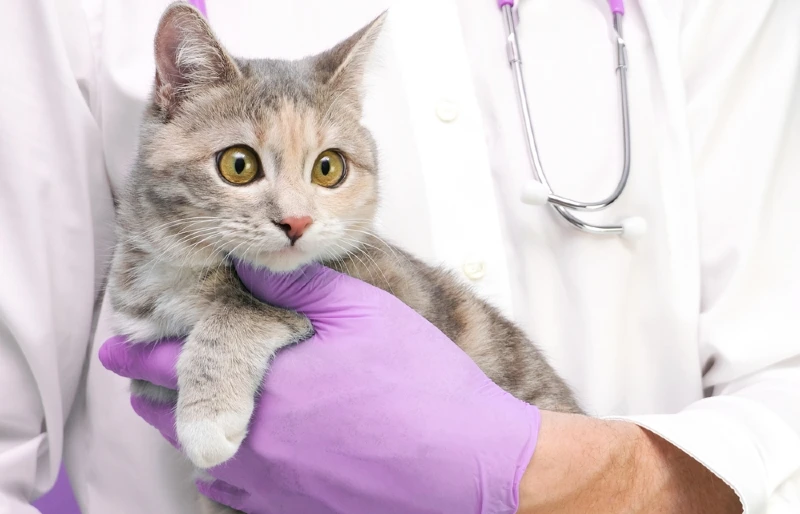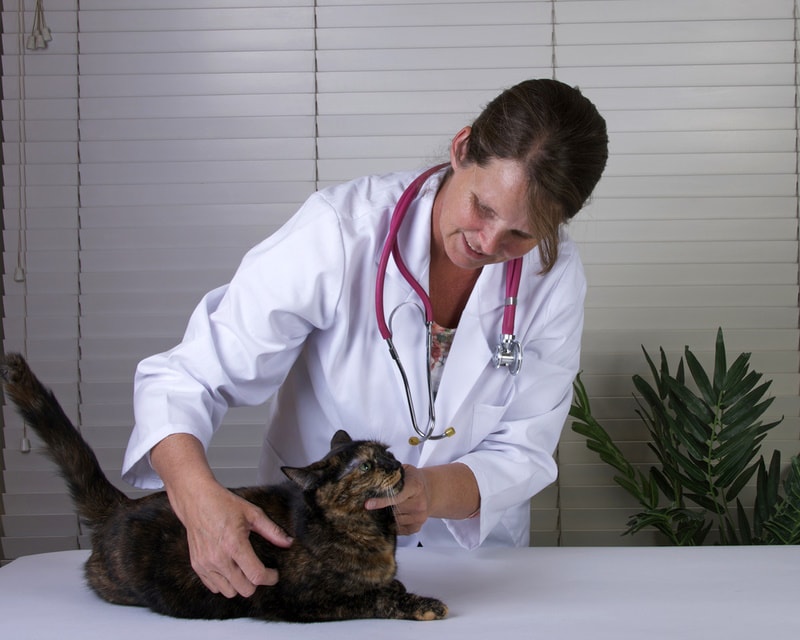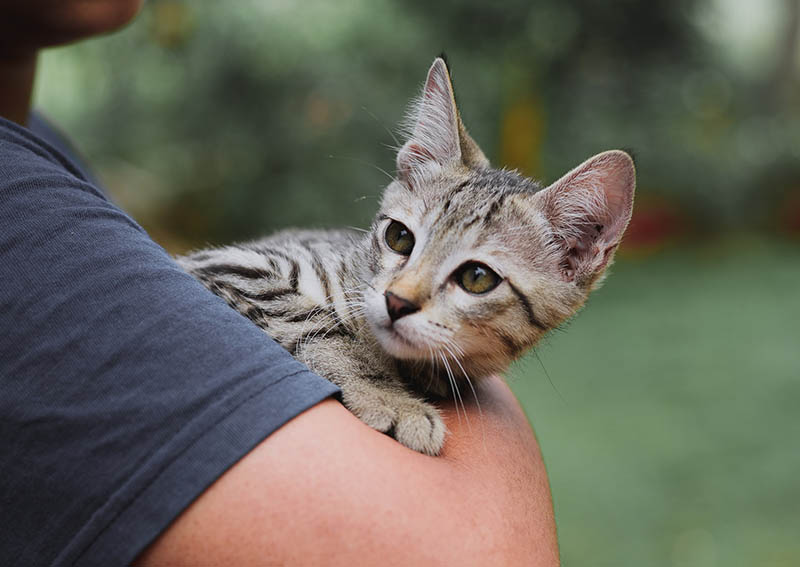How to Pick Up a Cat Like a Veterinarian: Vet-Approved Tips & Guide

Updated on

Click to Skip Ahead
It’s hard to pick up a scared or injured cat without getting scratched or bitten, especially if they’re not used to being handled. However, learning to pick up a cat like a veterinarian can help make the process safer and less stressful for you and your feline friend. This guide will walk, or paw, you through the steps to pick up a cat like a professional veterinarian.
Preparation
The tips and recommendations provided in this article are for a relatively friendly pet cat that is used to your presence. These techniques shouldn’t be used as a guide when attempting to restrain or pick up a fractious cat.
Before you try to pick up your cat, make sure you have everything you need. You’ll need protective clothing, such as long sleeves and gloves, if you’re concerned about being scratched or bitten. You may also need a cat carrier or a blanket to wrap the cat in once you’ve picked them up. It’s also helpful to be calm and relaxed, as cats are sensitive to human emotions and may become agitated if they sense that you’re nervous or anxious.
In addition, it’s advised to check for some signs to ensure that your cat doesn’t mind your approach. These include the following:
- Your cat responds to your approach by meowing or purring and seems inquisitive about you
- Your cat is happy about your approach and walks close to you, head-butting or rubbing your legs, with their tail held upright
- Your cat rolls on the floor and exposes their belly as you approach

How to Perform the Two-Hand Pick-up Technique Like a Veterinarian
1. Approach the Cat Slowly
Approach the cat slowly and calmly, avoiding sudden movements that can startle them. Keep your hands at your sides or behind your back to avoid reaching toward the cat. Talk to the cat calmly, soothingly, and allow them time to sniff and investigate you.

2. Position Yourself Correctly
Position yourself correctly before attempting to pick up the cat. Make sure that you’re on the same level as the cat and facing the same direction as them. Kneel down on one knee or sit down cross-legged to create a stable base and reduce the risk of falling.
3. Use a Two-Handed Technique
Use a two-handed technique to pick up the cat, which provides support and stability. Place one hand under the cat’s chest, with your palm and fingers supporting their front legs, and the other hand under their hindquarters, with your fingers supporting their hind legs. Lift the cat slowly and smoothly, keeping them close to your body.

4. Hold the Cat Securely
Hold the cat securely against your body, keeping them close to your chest. Use your hands to support their weight and prevent them from slipping or wiggling. Keep the cat’s head and body in a straight line to prevent them from twisting or struggling.
Some cats have an affection for high perches and are called “shoulder cats” because once picked up, they love climbing onto their owner’s or caretaker’s shoulders. If your cat is a shoulder cat, the first time they climb up on top of you might be a surprise. However, it is important to stay calm regardless.
The easiest way to get a shoulder cat off you is to slowly sit down on a chair, bed, or couch. The loss of height usually bores a shoulder cat to the point where they will jump off and seek other perches. Attempting to pull them off isn’t advised, as your cat may panic and dig their claws into your shoulder while you struggle to pull them off.
5. Avoid Over-handling
Avoid over-handling the cat, as this can cause stress and anxiety. Once you’ve picked up the cat, hold them only as long as necessary and put them down gently as soon as possible. Monitor the cat’s body language and behavior to determine when they’re ready to be put back down.

Frequently Asked Questions
Why do some cats hate being picked up?
Cats may hate being picked up for several reasons, including fear, anxiety, and discomfort. They may also feel vulnerable when off the ground, making them more likely to scratch or bite.
What should you do if a cat scratches you when you pick them up?
If a cat scratches you when you pick them up, wash the wound thoroughly with soap and warm or cool water and apply an antiseptic ointment. Monitor the wound for signs of infection and seek medical attention if necessary. If the cat that scratched you is stray or feral, you should promptly seek medical advice from a doctor, no matter how inconsequential the scratch may appear.
How do you put a cat down safely?
To put a cat down safely, slowly lower them to the ground while supporting their weight with your hands. Make sure that the surface where you’re placing them is stable enough for them to land on. Also make sure to avoid letting go too quickly or dropping them.
Can cats get stressed if you pick them up too often?
Yes, some cats can get stressed if you pick them up too often. Cats may become anxious or experience stress from being handled, which can lead to health problems. Always be mindful of the cat’s body language and allow them time to explore independently without frequently handling or picking up.

What should I do if my cat is scared of being picked up?
If your cat is scared of being picked up, try to calm them down first by talking to them in a soothing voice and gently stroking their fur. If the cat is still feeling anxious, allow them time to acclimate to the environment before attempting to pick them up again. If this doesn’t help, seek advice from your vet or an animal behaviorist for further assistance.
Are there any signs that a cat is about to bite or scratch when being picked up?
Yes, there are several warning signs that a cat is about to bite you or scratch you when being picked up. These include hissing, growling, swatting, and flattening their ears against their head. If you notice any of these, stop trying to pick the cat up. Allow the cat to explore independently until they are more comfortable. Understanding your cat’s body language is key to a safe and successful picking-up experience.
Are there any medical conditions that can make it painful for my cat to be picked up?
Yes, there are several medical conditions that can make it scary or painful for a cat to be picked up. These include arthritis, joint pain, muscle stiffness, and other age-related issues. Always consult with your vet if you suspect that picking up your cat is causing them discomfort or pain. They may recommend lifestyle changes or medications to help relieve their symptoms.
Conclusion
Picking up a cat like a veterinarian takes practice and patience. Using a two-handed technique, correctly positioning yourself, and avoiding over-handling can help make the process safer and less stressful for you and your cat. Remember to approach your feline friend with calmness and patience and be prepared to adjust your technique to suit their unique needs or personality. With some know-how and practice, you’ll pick up your cat like a pro in no time.
Featured Image Credit: lev.studio, Shutterstock












